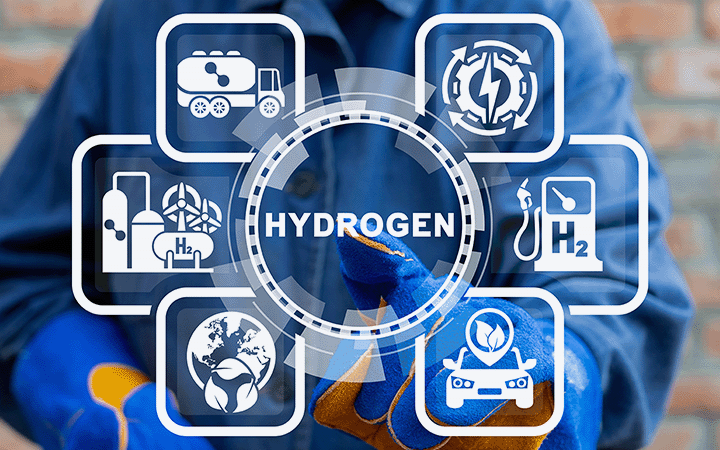
Dew-point measurement systems for intrinsic safety in explosive and hazardous areas
Personnel safety in industrial or process-driven work environments has always been top priority for regulatory bodies worldwide. Consequently, the UK’s Health and Safety Executive (HSE) has defined a hazardous area as, ‘any place in which an explosive atmosphere may occur in quantities such as to require special precautions to protect the safety of workers.’ Although the precise wording may vary from country to country, this definition is generally echoed by safety bodies and industries around the world.
For an explosion to occur, there has to be three vectors: a fuel (flammable gas, liquid, powder or dust); a sufficient concentration of oxygen (above the fire ignition threshold of 16.2 %); an ignition source (flame, hot surface, static discharge or electrical spark). Removing one or more of these vectors will prevent an explosion.
However, in many applications, the raw material or product being used or processed is the fuel source. This can range from natural gas and refined petroleum derivatives to vapors from chemicals and solvents, and powdered products such as milk and flour. Therefore, removing the source of fuel as a vector is not an option.
In most instances, eliminating the presence of oxygen is impractical. If the location does not require staff and can be enclosed, it may be possible to introduce an inert gas/air mix: for example, increasing the concentration of nitrogen to reduce oxygen levels safely below the ignition threshold. But, in larger production or process areas, external locations or applications where workers are needed, reducing the content of oxygen in the surrounding atmosphere is not possible.
The best option is usually to either remove the potential source of ignition or isolate it in such a way that it ceases to be a risk.
Controlling these factors depends on a combination of common sense and best practice, as defined by health and safety organizations, together with the correct design, installation and operation of electrical equipment. This has to conform to the standards set by national and international safety bodies, such as ATEX, UKCA, IECEx, GOST and TR CU, NEC and CEC.
Hazardous area categories
In general, a series of categories forms the basis of specifications for products such as the Explosion-Proof Easidew PRO XP. This device is manufactured for use in explosive areas. The categories define the application for which the product is designed, the rated environment, the product’s safety level, gas group, rated operating temperature and equipment protection level. See the example below:

Intrinsically safe (I.S.) products
Intrinsically safe products are manufactured so the energy they require or generate is reduced to a level that will not cause ignition: e.g. the risk of a spark is eliminated when using the Easidew I.S. Dew-Point Transmitter, and operating temperatures are kept as low as possible. Additionally, they will often incorporate components such as specialized fail-safe mechanisms, galvanically isolated outputs, advanced seals and enclosures rated to IP65 or higher.
At Michell Instruments, we have a complete range of intrinsically safe explosion- and flameproof sensors and systems for measuring water dew point, trace moisture and hydrocarbon dew point.
These include the Easidew I.S. Dew Point Transmitter, the Explosion-Proof Easidew PRO XP and the Liquidew I.S. Moisture in Liquids Analyzer.
It should be noted that fitting an intrinsically safe and certified dew-point sensor or transmitter does not make the entire moisture or hydrogen dew-point measurement system I.S. In a typical I.S. system, the safe operation of each part is dependent on the integrity of all the other components: for example, the safety of a dew-point sensor will be dependent on the amount of energy supplied through a power interface, which may be inside or outside the designated I.S. zone. Therefore, careful system design and installation is critical; our team of I.S. experts provide extensive advice and technical support to ensure that I.S. dew-point and moisture measurement systems are specified and operated efficiently and safely.
We have a team of hazardous area experts for moisture installations.
Learn more about our range of dew-point products
With almost 50 years’ experience in the development of innovative precision sensors, we are the application experts in dew-point and gas measurements for all specialized hazardous and explosive area applications. If you would like to discuss your requirements, please contact us today.
Related Blog Posts
How to Achieve the Best Results from Specialist Industrial Gases
Measuring Dew Point in Medical Gases
Precise Measurement of Moisture in Natural Gas
SenzTx Oxygen Transmitter: 3 Key Factors to Consider
Moisture Measurements in Dissociated Ammonia for Metallurgical Processes
How to Measure Dew Point in Ultra-High-Pressure Gas
What are Safety Integrity Levels and What do they Mean for your Process?
Achieving Pure Nitrogen Production On Site Safely for Hazardous Areas
Which Measurements Ensure Safety and Purity of Hydrogen Gas in Storage and Transport
What to Look for when Choosing a Portable Dew-Point Tester for Natural Gas
What are the Best Analysis Techniques to Ensure Quality of Hydrogen in Production?
Sources:
HSE (Health and Safety Executive): Hazardous Area Classification and Control of Ignition Sources
Related Products
Moisture in Liquid Analyzer - Michell Liquidew I.S.
Intrinsically Safe Dew-Point Transmitter - Easidew I.S.
Explosion Proof Moisture Transmitter - Easidew PRO XP
Want to see more information like this?
Sign up to one of our Industry newsletters and you’ll receive our most-recent related news and insights all directly to your inbox!
Sign Up